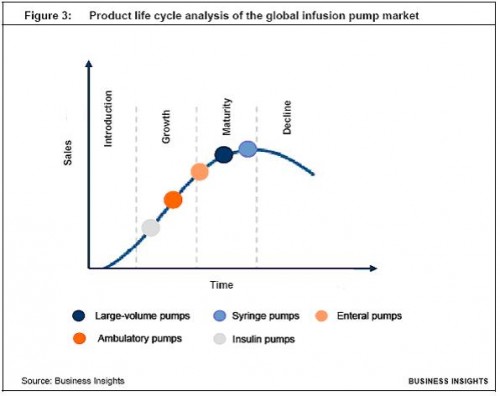The Infusion Pump Market Outlook to 2016
10 Jun 2011 • by Natalie Aster
“Infusion pumps with specialized applications will drive market growth. The improving reimbursement scenario for cost-effective and portable devices will ensure better adoption rates for alternate-site infusion systems. The market will also be driven by increased revenues from after-sales service and annual maintenance contracts.”
The report “The Infusion Pump Market Outlook to 2016” by Business Insights strategically analyzes the competitive landscape of the infusion pump market and projects the future trends in terms of new product development, focus on emerging markets, and new vendors to watch out for. The report also provides forecasts for the various market and geographic segments and projects the upcoming trends in technology and product innovation cycle.
The highly saturated US market will provide continued demand for disposable sets. The profit margins for large-volume pumps and syringe pumps will suffer a price erosion of 5% per year. Emerging markets such as India, China and Brazil will offer high growth opportunities for medium to low cost syringe pumps, ambulatory pumps, and enteral pumps.
Software glitches, confusing instructions and battery failures have been some of the major challenges affecting the uptake of infusion pumps. End users have responded to such challenges by forming multidisciplinary task forces to assess and analyze the root causes for infusion errors.
Report Details:
The Infusion Pump Market Outlook to 2016
Published: May 2011
Pages: 135
Price: US$ 3,835
Report Sample Abstract
Gravity-controlled infusion pumps
The drip-rate regulators are infusion pumps that rely exclusively on gravity to regulate the flow of medication. These are the simplest and least expensive infusion pumps containing a dosiflow and standard intravenous fluid administration sets. The rate of infusion is dependent on pressure difference across the valve. Drip-rate controllers also work on a similar principle whereby the force of gravity provides the infusion pressure. It further contains a drop sensor attached to the drip chamber to sense the drip rate. This feedback system is capable of adjusting the drop rate to a preset value.
Positive-displacement pumps
The positive-displacement pumps use a motor to provide a positive displacement of fluids. The mechanism of action for these pumps is either peristaltic or piston based. These pumps also utilize either linear or rotary mechanisms.
As indicated in Figure 3, syringe pumps represent the most mature market segment in the infusion pump market. Although driven by large volume sales, there have not been any significant technology innovations in this segment. As a result, syringe pumps now represent a saturated market with volume sales driven by the replacement of existing installations. Although highly mature, the syringe pump market is not yet expected to undergo a decline in sales, owing to a short replacement cycle. The large-volume infusion pumps have also reached an early maturity state in the product life cycle. Minor innovations in the smart pumps and product differentiation strategies have helped sustain volume sales for major manufacturers in this segment. Enteral pumps, on the other hand, have reached a late growth stage.
Limited competitive offerings by Baxter will ease competition
As a replacement for the Colleague pumps, Baxter is offering Sigma Spectrum infusion pumps to the US hospitals. However, the product is a single-channel pump and hence does not match a hospital’s demand for multiple infusions. On the other hand, competitors seeking to capture this market segment have a variety of value-added offerings for hospitals. These offerings include both single- and triple-channel pumps, options of financing, and competitive pricing.
Changing end-user loyalties will aid sales efforts of major competitors
The recall of Baxter’s Colleague infusion pumps has prompted many end users to doubt the overall infusion pump offerings of the company. According to an end-user survey conducted by the Emergency Care Research Institute (ECRI) in June 2010, only 16% of the respondents felt that the Colleague pumps were reliable and had fewer problems compared with other infusion pumps. The sample interviewed for this research consisted of 264 respondents from various hospitals across the US.
More information can be found in the report “The Infusion Pump Market Outlook to 2016” by Business Insights.
To order the report or ask for sample pages contact [email protected]
Contacts
MarketPublishers, Ltd.
Tanya Rezler
Tel: +44 208 144 6009
Fax: +44 207 900 3970
www.marketpublishers.com
Analytics & News


